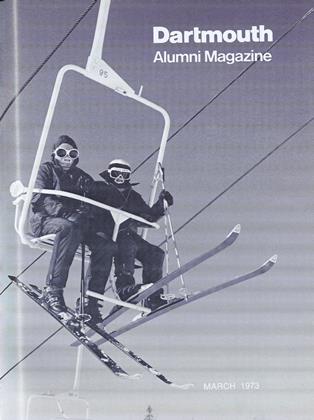James C.Risk '37. London: Spink and Son, 1972. 214pp. Illustrated. Available at Coin Galleries. 123West 57th St., New York, N. Y.. at $12.50 postpaid.
O tempora, O mores! "In the four corners of the globe, who reads an American book ... ?" Thus, in sheer ignorance, wrote Sydney Smith with his accustomed sneer at any thing not English in the Edinburgh Review in 1820. In 1969 the officers of the Order of the Bath invited a New Yorker, James C. Risk, Dartmouth College, 1937, sometime officer in the United States Navy and in the Foreign Service, an American in short, to write the history of that honorable body and of its insignia. The result is that after 1972, anywhere on this earth, yea, in outer space also, the person who desires to know something about the Bath will have to read this American's book, for it is the official history.
The ancient Knighthood of the Bath was "erected"by King George I on May 11, 1725, into a military order of knighthood designated The Order of the Bath. Since that time the order has undergone a variety of changes, some of which. as Mr. Risk describes them, were very curious indeed. In truth, in ways typicaĺy English, it took the order over a century to develop into a baody for rewarding individual achievement.
The autkor's sckolarskip is meticulous and nresenled witk impressive detail. It is antiquarianism at its very best, Even Sydney Smith could have uncovered few flaws in this correctly written. often vivid, and oçasionally witty narrative. Instead of members, Mr. Risk mentions only those individuals who influenced the evolution of the Order.On the other hand, he is most successful in placing the story of the Bath in its proper context in general English history and in showing how the concept of the order was molded by the times. The chronicle if refreshingly brief - only 109 pages of text.
As a recognized authority on british orders and decorations, Mr. Risk has supplied two final chapters on the insignia of the Bath, which is a special contribution to numismatic lore. A beautifully produced portrait of Quèn Elizabeth II in her mantle and insignia serves as the frontispiece of the volume, and 28 plates (three of them in color) complete a handsome book. The American has given the English a history which is in every way definitive and truly a model for this genre.
Professor of History, Emeritus, at BrownUniversity, Mr. Bridenbaugh is author of manyarticles and books. Among his recent publicationsare Mitre and Sceptre (1962), Vexed and Troubled Englishmen, 1590-1640 (1968). and No Peace Beyond the Line (1971).
 View Full Issue
View Full Issue
More From This Issue
-
 Feature
FeatureSailing Dreams and Random Thoughts
March 1973 By JAMES H. OLSTAD '70 -
 Feature
FeatureNotes Towards a "Whole Life Catalog"
March 1973 By ALAN T. GAYLORD, DIRECTOR -
 Feature
FeatureTHE ACRONYM SYNDROME
March 1973 By JAMES L. FARLEY '42 -
 Feature
FeatureFACULTY WOMEN
March 1973 -
 Feature
FeatureUNDERGRADUATE JOURNAL
March 1973 -
 Article
ArticleBrautigan's Search for Reality
March 1973 By RICHARD D. CARYOLTH '73
CARL BRIDENBAUGH '25
Books
-
 Books
BooksTHE DIARY OF A RAPIST.
JUNE 1966 By CLIFF JORDAN '45 -
 Books
BooksINDEX TO TOP-HIT TUNES (1900-1950).
JANUARY 1963 By GENE MARKEY '18 -
 Books
BooksAN INTRODUCTION TO PUBLIC OPINION
July 1940 By Michael Choukas '27 -
 Books
BooksCOLLECTIVE BARGAINING COMES TO THE CAMPUS
November 1973 By ROBERT M.MACDONALD -
 Books
BooksTHE STRUCTURES OF THE ELEMENTS.
December 1974 By ROGER H. SODERBERG -
 Books
BooksTHE WELFARE STATE
December 1950 By VIRGINIA L. CLOSE




